-
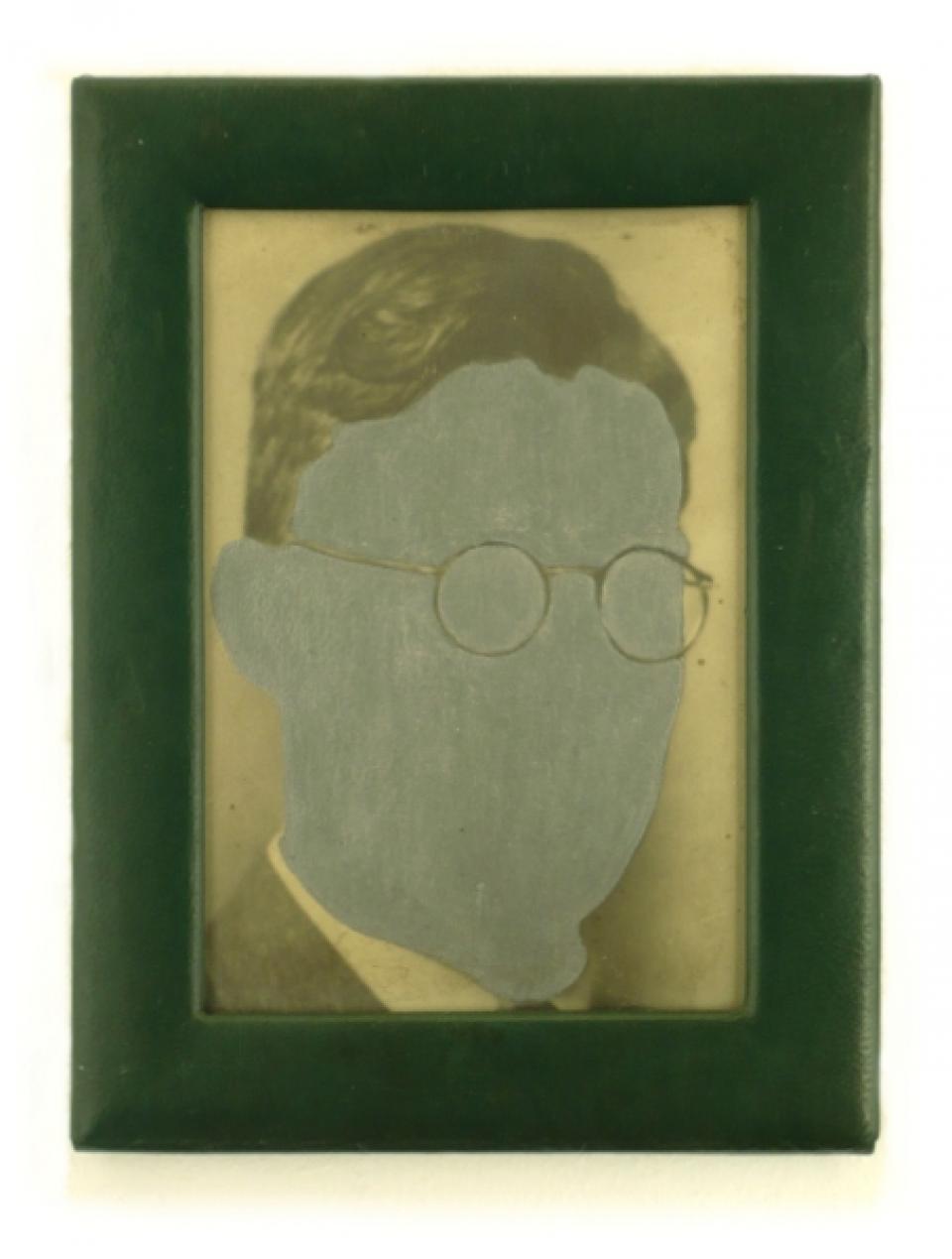
Echtes Leder, 2010, iridescent color on photography, leather frame, 16 x 12 cm
-
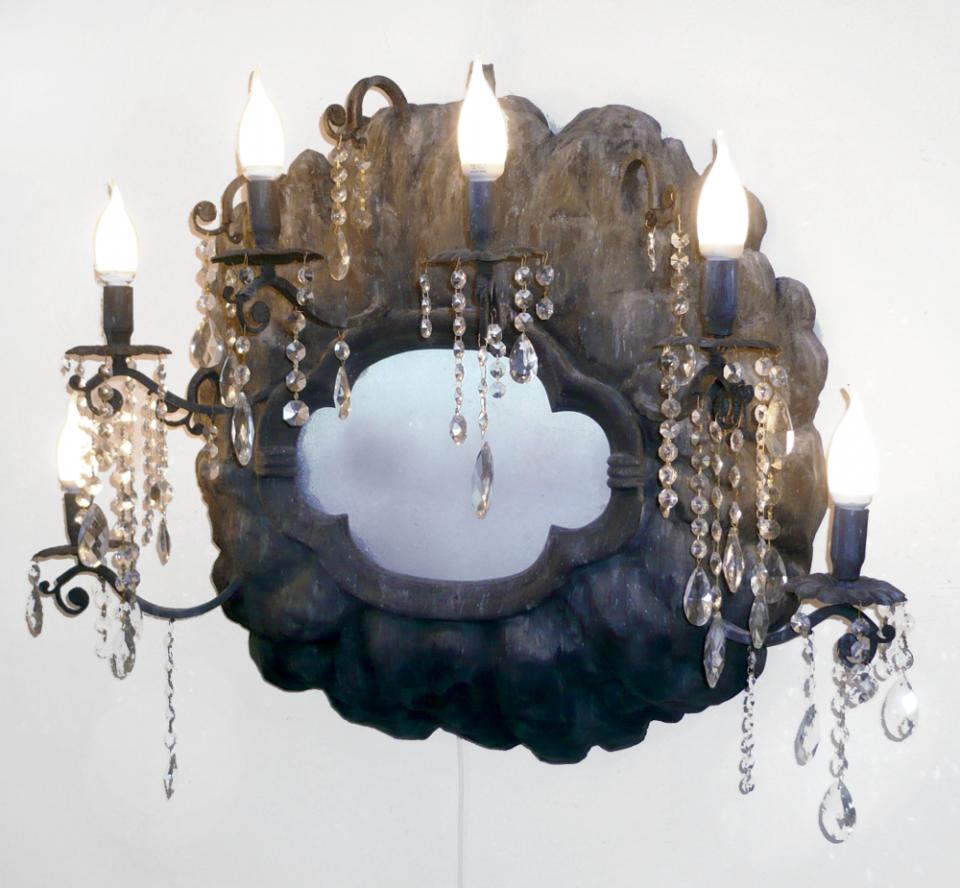
Sehnsucht II, 2013, mixed media, ca. 68 x 83 x 34 cm
The frame looks like a dirty, black boulder. The opening allows a glimpse into a grotto-like interior, the back of which has an extremely vague, foggy landscape appearance. The warm light of the candlesticks contrasts with the cool light inside, turning the interior of the object into a perceived exterior.
-

Wenn Ich groß bin, wird das Leben aufregend und spannend., 2013, mixed media, 50 x 38 x 13 cm
In the showcase there is an iridescent kitsch picture from which glass fibres of different lengths protrude. They conjure up small, brightly coloured dots in the space in between (see detailed view below). On the bottom of the showcase there is a layer of dust, dirt and cigarette ash, interspersed with fine, glittering glass splinters. The showcase is velvety on the outside, interspersed with various small pieces of gold leaf and glitter and mica particles.
-

Box, 2013, mixed media, 43 x 31 x 12 cm
Around a small, hardly recognizable picture of Jesus, the saying "I am the way, the truth and the life" is embroidered on the net with little grey pearls. The two side openings are also lined with net. Inside the box you can see the inner life of an old Hi-Fi device.
-

Ich mag mich, 2013, mixed media, 43 x 31 x 12 cm
The organically shaped, pink-coloured structure in the centre of the picture is surrounded by a delicate, slightly silvery ellipse in the shape of a planetary ring.
The surrounding planets are backlit, the numerous, tiny stars sparkle brightly. At the lower edge of the box is the metal trim of a stereo system with the brand name "Universum". -

Der Traum, 2012, mixed media, 39 x 37 x 12 cm
In the small opening of the box the picture of a landscape with palm trees, suggested snow-covered mountains, moon and bird of prey shines, as they can also be seen on the poster "tame birds singing of freedom / wild birds flying" (Tommi Krippner, 1980).
Vaguely distorted music fragments come out of the box, based on the melody of "Der Traum ist aus" by the band "Ton Steine Scherben" (1972).
Sound realisation by Simon Roessler -
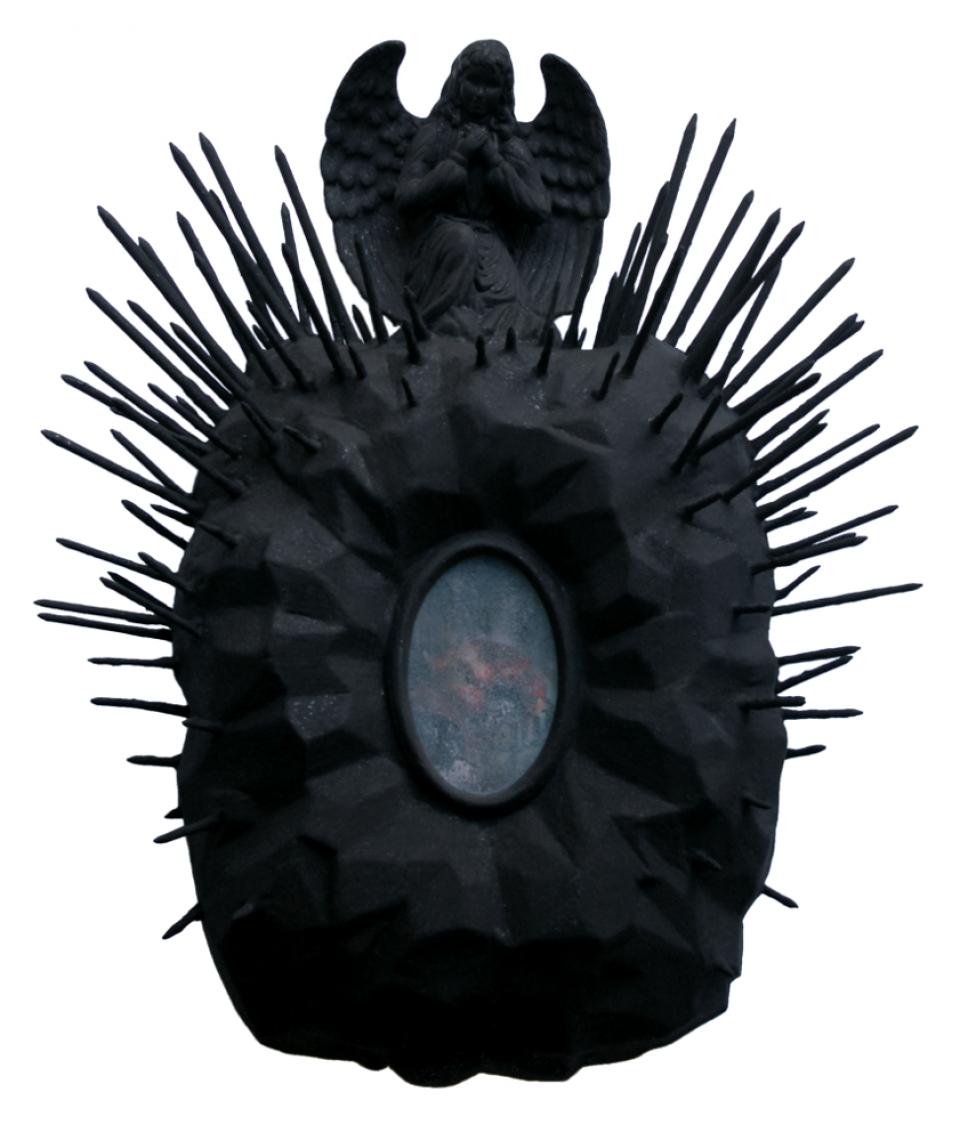
no title, 2012, mixed media, 61 x 51 x 17 cm
The surface of the voluminous frame is similar to coal, a matt black interspersed with mica. Behind the dusty, almost opaque pane you can only imagine artificial flowers and a rusty cola can.
-
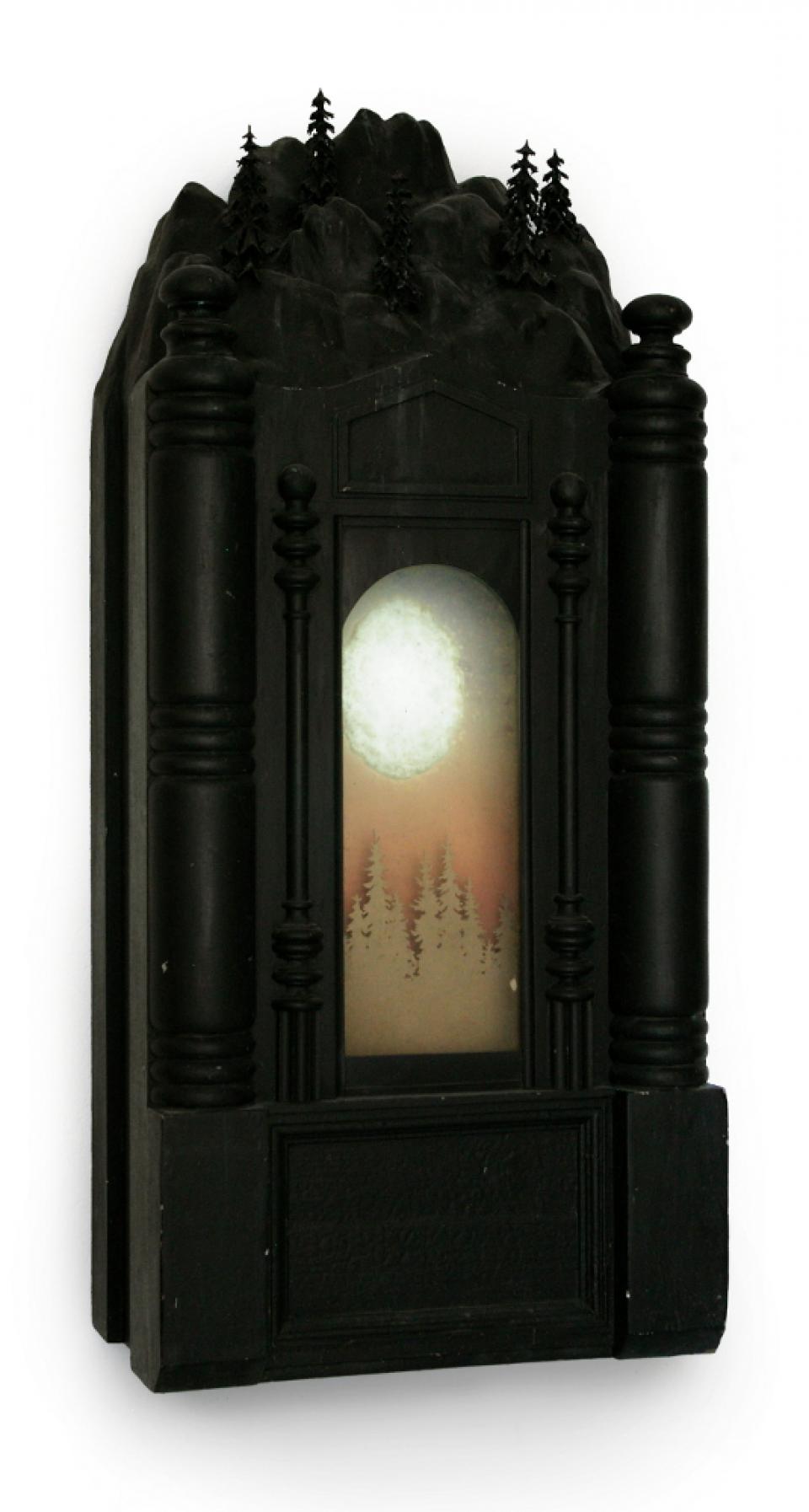
Großes Erscheinungswölckchen, 2012, mixed media, 96 x 43 x 24 cm
The elaborate case, reminiscent of a watch case, is covered with dust and scratched. In spite of the model railway spruces, it gives the impression of being very old. Behind the dirty glass is a silhouette of a spruce forest cut from grey cardboard. In the sky inside the showcase, a "appearance cloud" shines.
-
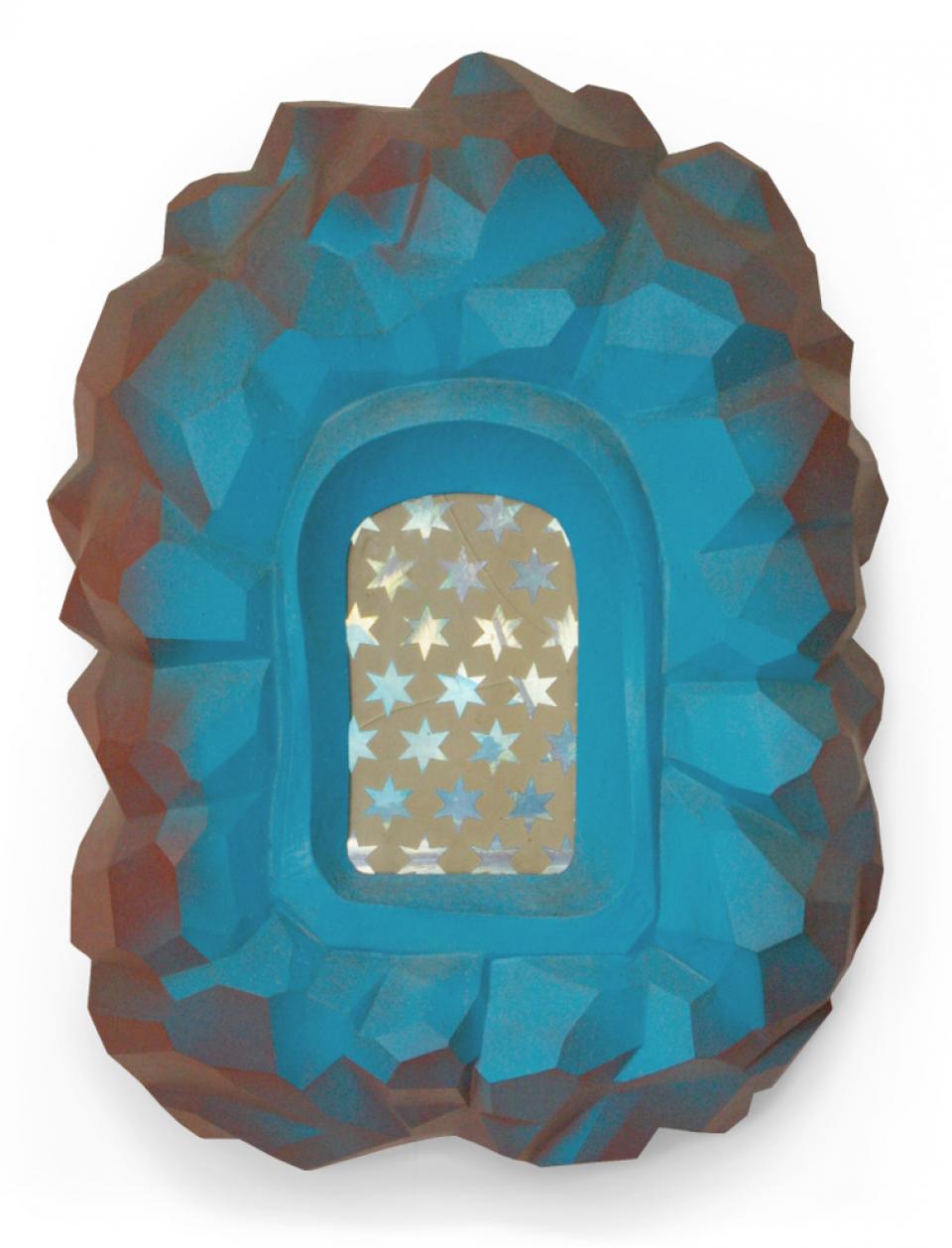
no title, 2012, mixed media, 58 x 43 x 10 cm
The frame is remotely reminiscent of a toy landscape relief. Dust seems to have settled on it, the glass has cracked. The star-shaped openings in the box allow a view into the interior. The interior is illuminated by a landscape with palm, mountain and lake in old-fashioned exotic romanticism.
-

Der Sprung, 2012, mixed media, ca. 90 x 85 x 10 cm
The image is reset behind the frame. The resulting interior of the image object, a few centimeters deep, is filled by the backlit image.
-

The End, 2011, mixed media, 104 x 71 x 20 cm
The oval opening allows a view of an evening coastal landscape in the brightly lit interior.
-

Sehnsucht, 2011, mixed media, 38 x 31 x 6 cm
Behind the passe-partout a little set back is a luminous, shadowy landscape and a vaguely indicated village. The soiled glass reinforces the impression of distance and rapture.
-

Struktur total, 2011, acrylic on hardboard, frame and passe-partout, glass pane, 17 x 22 cm
Frame, passe-partout and picture surface are covered with a structural mass.
-

Bootsfahrt, 2011, mixed media, 66 x 64 x 16 cm
The word "sex" lights up red through black tissue paper. On both sides of the box there are two openings, each lined with a fly net. One can imagine a complex confusion of cables and technical components inside the box.
-

no title, 2011, mixed media, 104 x 79 x 11 cm
Behind the oval passe-partout and a dirty glass pane there is a brightly shining surface that suggests a spatial depth. The diffuse cloudy spots refuse a pictorial interpretation, but at the same time they seduce the eye to search for such clues.
-

Bist Du Opfer dunkler Mächte?, 2010, acrylic on hardboard, glass, frame, 44 x 36 cm
-

Stern, 2010, carton, photography, glass, frames, 35 x 26 cm
Through the star-shaped opening a small image section of an old photo set back behind it can be seen. This shows a hand holding something indefinable in the direction of the viewer.
-

Nebel, 2010, acrylic on hardboard, glazed showcase with superstructure, technical device, 92 x 46 x 20 cm
The picture is set back behind the passe-partout and is illuminated from the side. This makes the center of the image darker. The resulting light effect mixes optically with the painted dark fog.
-
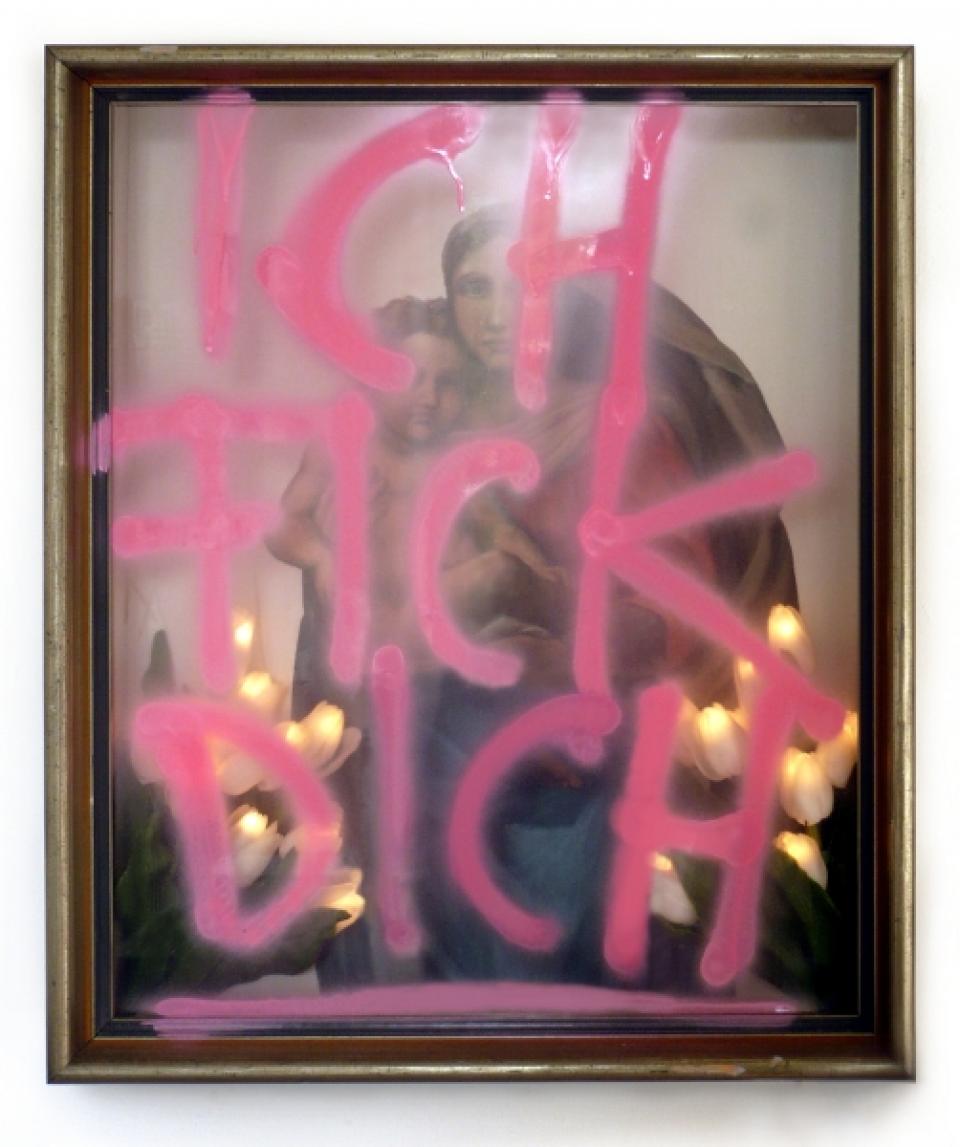
ICH FICK DICH, 2010 , acrylic on hardboard, illuminated plastic tulips, glass pane with graffiti, showcase, 83 x 69 x 13 cm
-

Jesus, 2009, acrylic on art print, glazed frame, 27 x 25 cm
-

RIVA dei SCHIAVONI, 2009, acrylic on art print, glazed frame, 20 x 30 cm
-

no title, 2009, iridescent color on photo, passe-partout, 68 x 58 cm
-
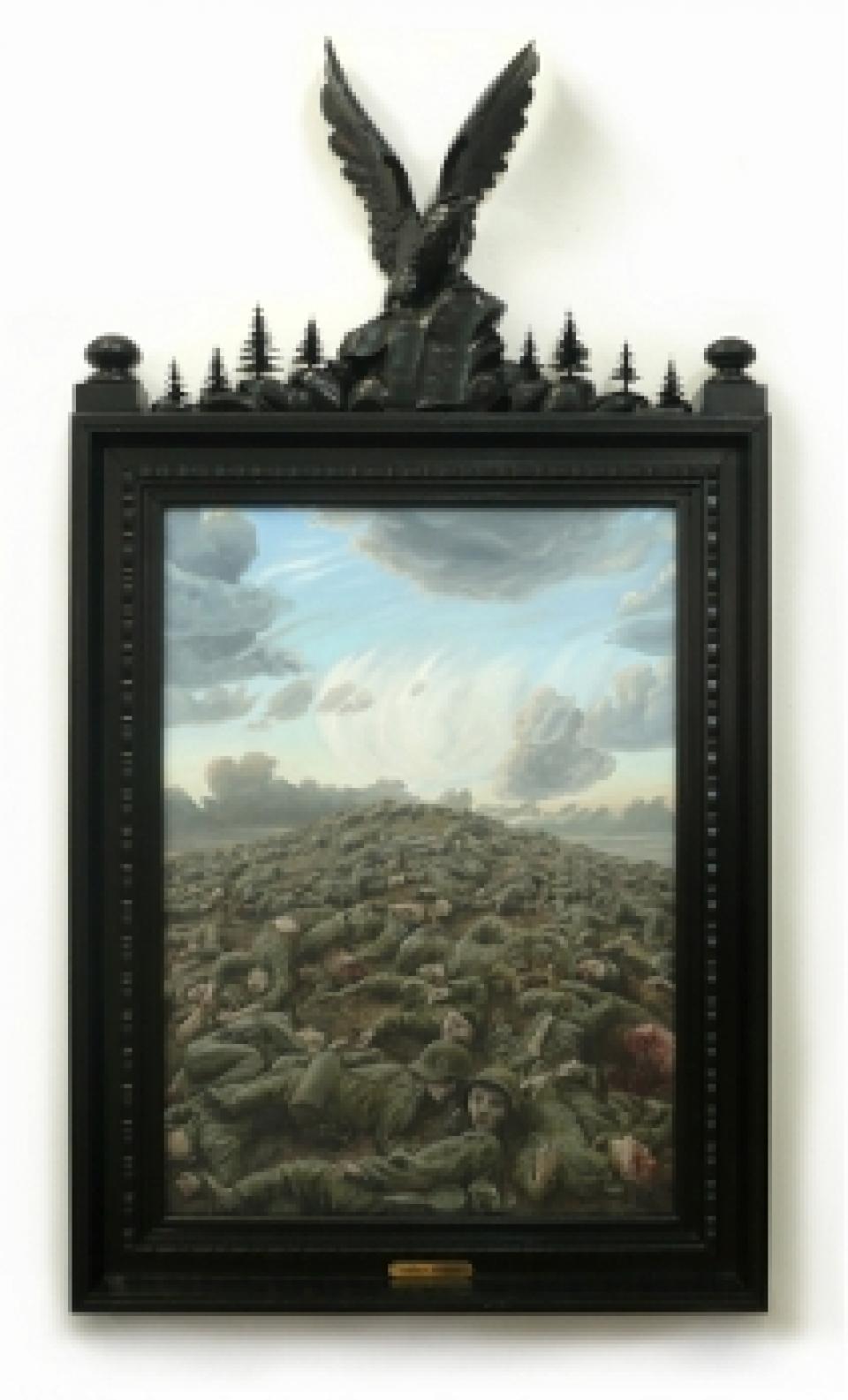
Schöner Himmel, 2009, acrylic, oil on hardboard, frame with deco construction, 124 x 66 x 8 cm
-

no title, 2009, acrylic on carton, glazed frame, 30 x 24 cm
-

Gloria I/III, 2008, lacquer, lead on hardboard, frame, 62 x 50 cm
"Umrahmt, gefasst und abgegrenzt."
Framework Program Between Imagination and Boundary
Picture frames, whose original function is to protect the pictures and present them, receive special attention from Thomas Behling. The artist does not regard them as purely embellishing ingredients, but as an equal part of the object design and acts in the sense of the medieval altarpiece, in which his works and their framings belong inseparably together. Behling works with magnificent, lavishly profiled frames as well as with simple, narrow strips that surround the picture field. At the same time, they form the order and reference frame of all picture elements as well as the action frame of the acting figures - a kind of window into his pictorial world.
The frames used by him show traces - paint flaking, missing parts, stains or cracks. They refer to the use and history of bygone days. Melancholy lies over these objets trouvés, which were once valued and adorned living spaces, which over time lost their significance and were forgotten before finally landing at the flea market, the place of dethroned memories. Behling snatches them from oblivion. Discovered and re-evaluated, they experience a metamorphosis as objects of his art. By loosening the statuary fixed situation, often for decades, Thomas Behling ends her Sleeping Beauty sleep. He changes content, changes motifs, empties the frame.
Framed in gold and raised to eye level, pictures generally experience an increased appreciation. Behling also makes use of well-known reminiscences of museum presentation by means of glazing or the use of title plates at the edge of the picture. But his discs, which he deliberately does not free from the dust of time, appear less reserved. On the contrary, it is precisely the thus perceptible inner sides of the actually translucent glasses that form clearly separating levels and direct the viewer's gaze into the space between the frames as the site of the picture's events. The artist plays with the showcase aspect of frames and the tension between presentation and separation. His pictures acquire their own presence in space, they become objects for viewing. Their frames bundle the viewer's attention and grant him insights, at the same time the glazing prevents direct contact and the artwork withdraws. Behling's framings can also be compared to a showcase in a protective and preserving sense, although their deliberately left traces of aging seem to contradict this. If, in addition, a disc has cracked, as in "no title“ (2005) refers in its fragility to the fragility of human existence and to the fact that what is preserved as well as what is preserved disintegrates over time.Framings are the inspiring material of Behling's works. They often lead him to the idea of the picture. The artist uses images with their original frames as well as solitary frames. When Behling enlarges a picture format in the course of his work, he looks for a suitable old frame or designs a "new" one. In addition, he artificially ages wood and paper by adding grain or mildew stains. In order to preserve the impression of historical authenticity, which lies like a patina on the material, his artistic interventions usually take place almost invisibly. He creeps into the pictures, takes over existing backgrounds, composes figures or uses silhouettes that cover parts of the picture and thus encode levels of meaning. Although he imagines an unbroken unity of picture and frame, Thomas Behling simultaneously disturbs the harmony achieved and thematizes appearances. On a lukewarm summer night, loneliness waits with an idyllic sparkling starry sky, or threat lurks on a romantic bench under the canopy of a protective tree. It is precisely the use of old frames that deliberately delays the viewing and realization of his alienated pictorial statements.
Thomas Behling often expands the distance to the disc by moving the back wall and thus achieves works that recall shrines of saints in depth and diorama character. Small, beautiful and surrounded by the aura of the transient, they also seem like private devotional images. In Behling's work, the theme finds artistic renewal in a supposedly deified and unstable world. Observing how people find support in their faith, he thematizes the difference between the imaginary and the haptic real precisely by means of the framed art space. To depict the immaterial and to transport it into experiential spheres also means to create a basis for it. This is where the delimitation of the imagination meets the delimitation of the image field.
To create new visual and acoustic effects, the artist also incorporates lights or sounds into some of his works. In addition, as in "o. T.“ (2005), glittering shimmering foils whose appearance changes with daylight. Also the "Ganzzkörperrüstung mit Sprechloch" (2005) irritates by distorted reflections. Here the metallic reflective image object is mounted directly on the back wall of the frame - a surface that normally does not appear. In Behling's work, it becomes a nuancedly iridescent picture background and technical, formerly purely functional details, such as the rivets of the picture display, are given meaning as formal elements of the composition.
Thomas Behling sets larger works in luxuriant frames that correspond both formally and stylistically with the content of the picture. For example, "Gott segne Eure Liebe" (2007) has a frame with stylized leaf ornaments that repeat the bushes of the scenery. The golden frame colour also shines in polished places like the stars in the background of the painting. In "Der kleine Junge hat Angst vorm Schwarzen Mann" (2007) the picture frame again corresponds to the neoclassical angel motif. Although it was made retrospectively, it retains the austerity and simplicity of the original. Finally, the "Schwellenmann" (2008) has a heavy wave frame, the formation of which can also be found in the picture, where fog covers the landscape in places and results in a wavy appearance of clear forms and schemes comparable to framing.
Thomas Behling achieves most color correlations between frames and their artistic content through the use of gold. In "Heiligenschrein" I (2005), the bright outline of the saint first corresponds to the delicate gold border of the frame. It is picked up in colour in the nimbus, while the second figure corresponds to the dark frame body. Behling often combines the composition into a whole by repeating colours. In "Gloria I/III" (2008), too, the relatively thick black frame appears like a color focus aligned to the silhouette of the saints, underscoring the narrow effect of the picture.
The entanglement of framing and painting requires special attention in "das Mädchen und der Schwarze Mann" (2006), where the male figure of the unequal couple only reveals human features on the hands. Surprisingly, the left arm of the figure shows a contrasting colour gradient from threateningly indefinite darkness to a light hand with a richer detail - a colour gradient that is also reproduced by the frame, whose peeling black colour repeatedly reveals the view of a lightly primed wooden background.
The "Heiligenbild IV" (2005) is surrounded by an extraordinary variety of colours and its frame is made up of countless artificial flowers. They encompass a shadowy saint and form a soft, plastic border that contrasts strongly with the monochrome picture surface. Finally, Behling's work "no title" experiences the highest heightening of the frame theme. (2006) - a kind of frame without content. By removing a document, the artist now removes the original pictorial object. Although the sheet also has a clip frame, this is clearly less prominent than the internal framing. This soon turns out to be an illusion, which nevertheless can go beyond its frame. The strange gap in the centre of the object is comparable to the numerous missing parts and scratches in other works by Thomas Behling. It invites us to reflect on given, existing frameworks and, as is often the case in the artist's oeuvre, can be understood as a symbol of transience and lost memory. This is additionally expressed by the traces of aging of paper, silver and glass as well as the rust of the framing elements.
As Behling's pictures usually take place in small, manageable framings, the artist initially moves "within the usual framework". The pictorial content he uses also seems at first to remain "within the framework of the general convention", but his artistic interventions counteract this by means of deviations and alienations. Thus the artist holds up a mirror frame in the figurative sense of society. The silver frame within the picture by "no title" (2006) also lends the object a representative character. It sets expectations and yet is empty. The frame alone forms the programmatic, artistic overall concept. An interchangeable frame, which appears firmly joined and durable, although it can be changed very easily, becomes a metaphor for the fast-moving nature of our time.
Corona Unger
Published in „Wenn Du noch Mut hast, so danke Gott und sei zufrieden“, 2008
_______________________________________________________________
"Ich bin schlecht, aber ich wäre noch viel schlechter, wenn ich nicht wüsste, dass ich schlecht bin." ("I'm bad, but I'd be a lot worse if I didn't know I was bad.")
A visit at Thomas Behling
As if from the "good old days" of our grandparents and great-grandparents, some of the motifs that Thomas Behling has created in recent years seem to come from a banana box, which he gradually takes out of our studio talk. Behind dusty, occasionally dull glass panes, framed by old frames, I see motifs from the "past", in which - as one might say - everything was much better. However, a closer look at the pictures in question raises doubts, because the idyll has subtle breaks. Behling plays with the homely atmosphere and the high recognition value of old pictures, but changes them in an irritating way.
In fact, many of the materials used by the artist come from flea markets, and so when you look at them you get the feeling that you have come across a collection of pictures that could have decorated a living room a long time ago. Thomas Behling enlivens yellowed photos, old prints or devotional images by making artistic interventions on them and turning them into his artistic material. The undeniable aura of these aged pictures is juxtaposed with the youthfully mischievous smile of the artist, who was born in Hanover in 1979 and completed his master's degree at the Hochschule der Künste in Bremen two years ago.
One of the works in question from 2008 has the title "Christ Knocking". The motif depicting Christ appearing surprisingly at the front door was extremely popular and widely printed in the century before last. Although Behling's work is indeed an old print from the flea market and the depicted Christ appears, as usual on corresponding prints, with a shepherd's crosier in a white robe by moonlight on a front door, Behling's artistic intervention transforms the motif into an alienating scenery. Using emery paper, the body of the Christ figure was carefully rubbed from the paper, thus creating a kind of void on the paper; only the head, the tapping hand and the feet have remained in their original form. The resulting recess has the effect that Christ appears to be spun into a cocoon, giving the scene an irritating character. What is now surprising is no longer that Christ appears at the front door, but how he appears there.
Anecdotes from the flea market or small stories from everyday life in the studio enrich our conversation, but are always replaced by Behling's reflections on the character of his work or by references to his art-historical reference persons. But even without the artist's explanations, the ironic refraction of his works is conveyed. The "Erscheinungswölkchen" ("Apparition Cloud") (2008), for example, created this year, unmistakably alludes to the landscape painting of the romantic Caspar David Friedrich. The conifers protruding into the pictorial space in front of a discreet evening blush recall various paintings by the Dresden artist, whose landscape paintings are interpreted as an expression of natural piety and in which the painter's religious feelings before and in nature become comprehensible. So if the landscape is a place of special experiences for Friedrich, in Thomas Behling's painting we become eyewitnesses to a "Erscheinungswölkchens" ("cloud of apparitions") in the sky. In a peculiar proximity to comparable motifs from the history of painting, to comic drawings, but also in correspondence with the "cloudy" cocoon of the knocking Christ, Behling succeeds in creating the ambivalence of sublimity and ridicule that he calls the picture.
In other works, Thomas Behling refers to an artistic process that Marcel Duchamp, for example, practiced: the overpainting of pictorial originals and the resulting possibility of changing their actual character through the intervention carried out. In 1919 Duchamp had changed a chrome print with the motif of the Mona Lisa in such a way that he added "Schnauz und Bärtchen" (Duchamp) to the smiling face, thus transforming the famous face of the Gioconda into a male face. Max Ernst also redefined pictorial motifs at the same time when he created the painting "Das Schlafzimmer des Meisters" ("The Master's Bedroom") on the basis of one page of a catalogue of teaching aids.
Thomas Behlings "im Paradies" from 2005 was created on the basis of a so-called light effect print. The print shows a heron standing on the banks of a river under the rank of leaves in the middle of an idyllic landscape. By adding a crouching human figure, the motif is turned into an unexpected encounter between man and animal. What should actually describe their self-evident and informal encounter as an idea of paradise, thus becomes an encounter of two unknown species.
Thomas Behling smiles while looking at his pictures. He is interested, he tells me, in the narrow line between the sublime and the ridiculous. He does not want to ridicule topics such as religion, spirituality or man's relationship to nature. On the contrary. Behling's work is an attempt to thematize various areas of human existence without speaking a language that seems consumed to him and without falling into pathos. How well he succeeds in this is shown by the work "der kleine Junge hat Angst vorm Schwarzen Mann" from 2007, which, as he mysteriously announces, he first has to hire.
Here first a picture template, which can be called kitschy without further ado, was changed motivically. Originally, the picture shows a small boy with a frightened look at the side of his slightly older sister, who on his way home only has to cross a little trusting wooden walkway to get to safety from a thunderstorm. Behind them, unseen by the children, an angel spreads his arms protecting them. Thomas Behling has not only changed the motif by painting a "black man" with a threatening pose in the picture, but has also created a technical device that - mounted behind the picture - emits "real" lightning as well as the corresponding thunder. The question posed in the nursery rhyme, „Wer hat Angst vorm schwarzen Mann?“ ("Who is afraid of the black man?") finds a highly individual answer here in the mixture of the edification picture and the King Kong figure.
The work of the artist Thomas Behling takes place between nostalgia, kitsch and - as in the last picture example - "bad taste", but also the models of art history. Even though he occasionally reveals a potential as a painter that can almost be called academic (see "Schwellenmann" from 2008), it is the reduced artistic means, the charms of the numerous small, inconspicuous formats and the witty hidden meaning that are able to convince.
Detlef Stein
Published in „Wenn Du noch Mut hast, so danke Gott und sei zufrieden.“, 2008
-

Schwellenmann, 2008, acrylic on hardboard, frame, technical device, 96 x 77 x 21 cm
Picture object with sound: a monotonous, slightly swelling and decaying sound between humming, buzzing and noise.
-
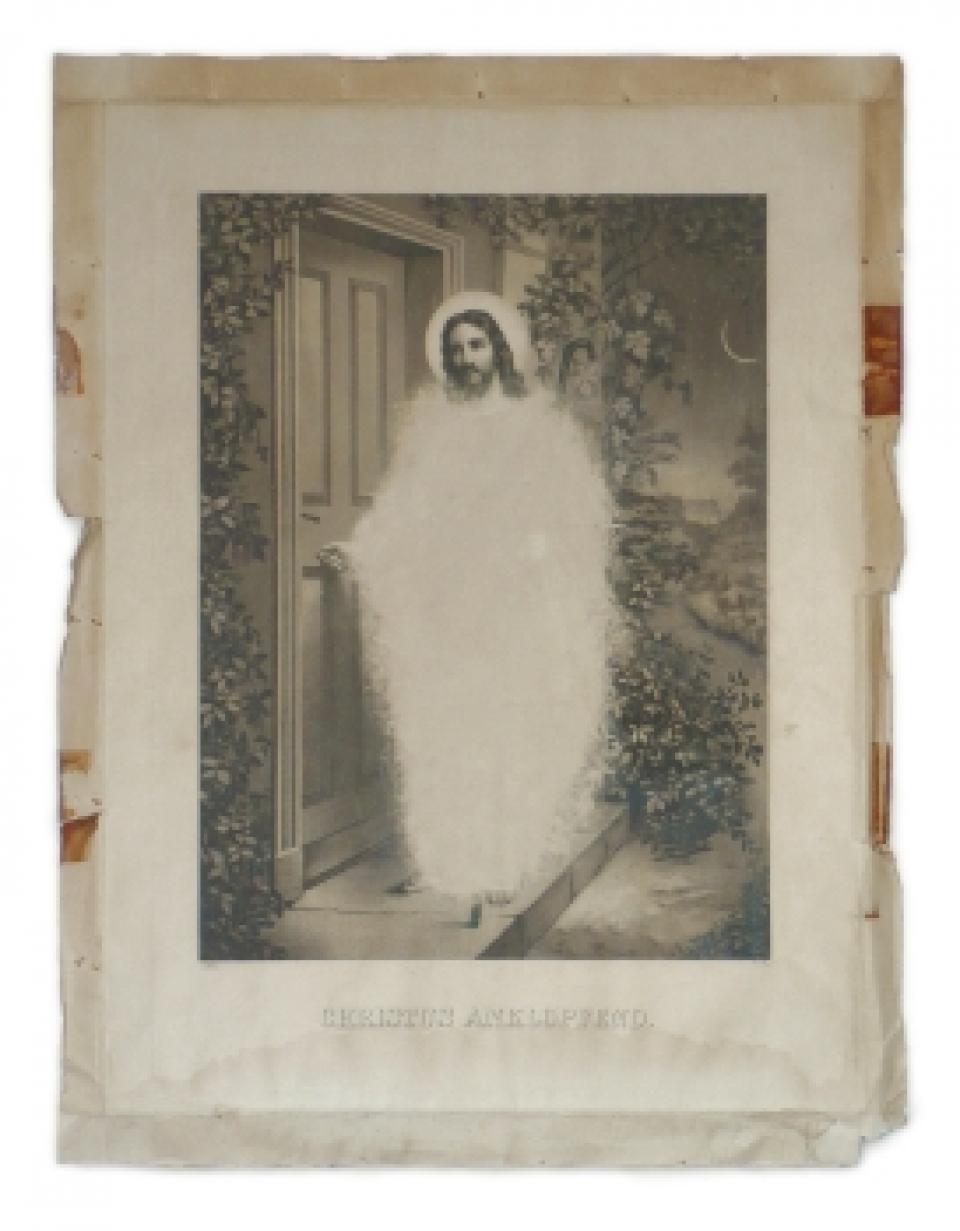
Christus anklopfend, 2008, polished old art print on paper, 50 x 38 cm
-
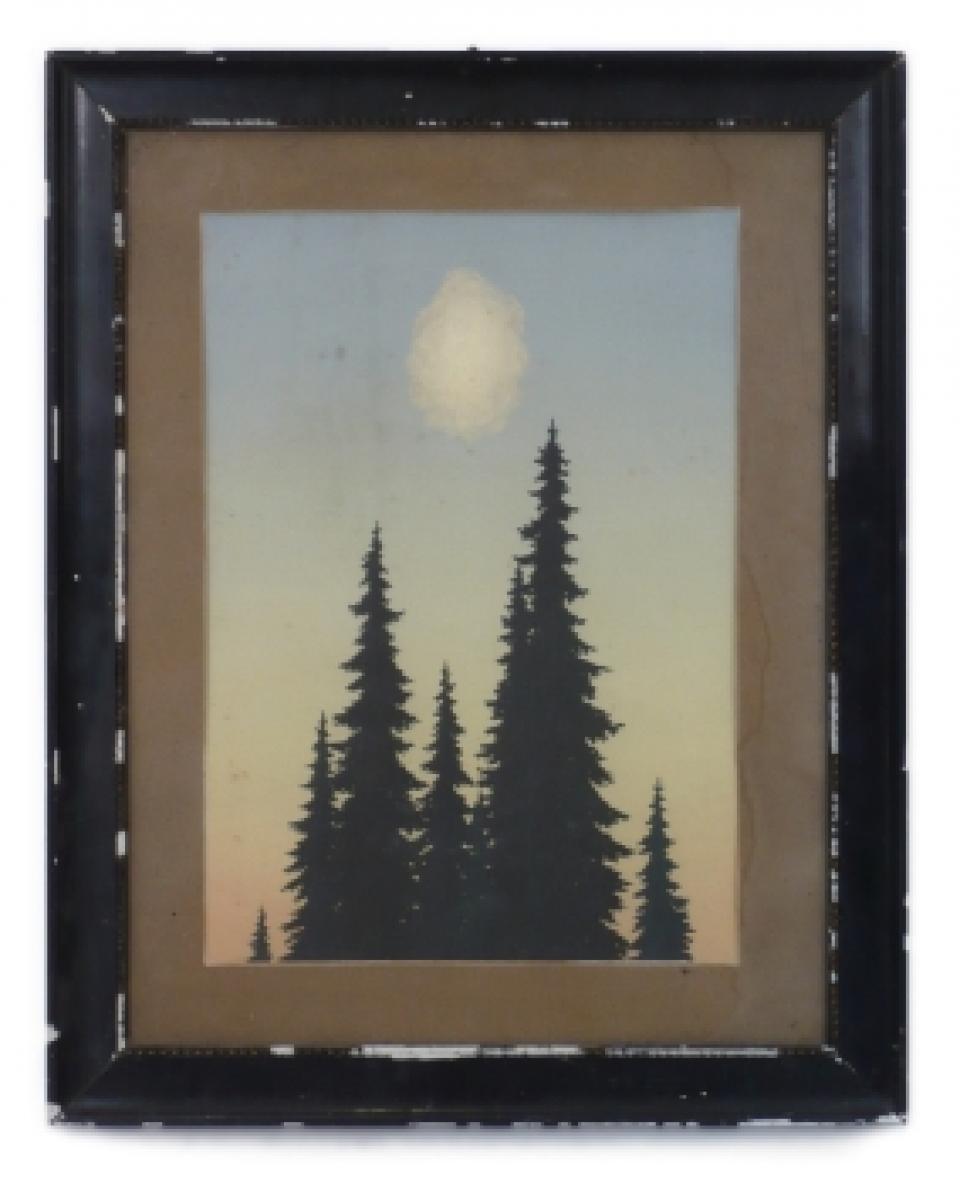
Erscheinungswölkchen I, 2008, acrylic on hardboard, glazed frame, 68 x 55 cm
-
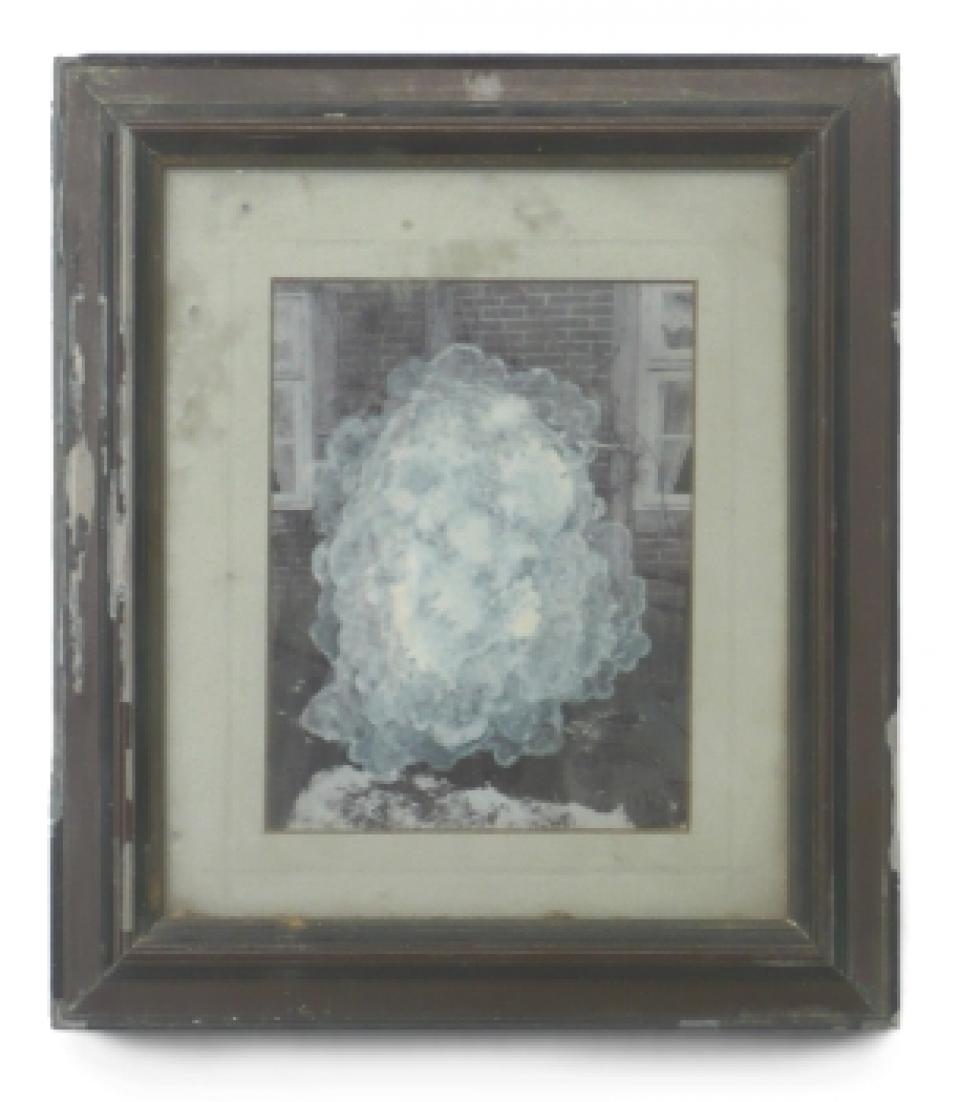
Erscheinungswölkchen II, 2008, acrylic on photo, glazed frame, 39 x 34 cm
-
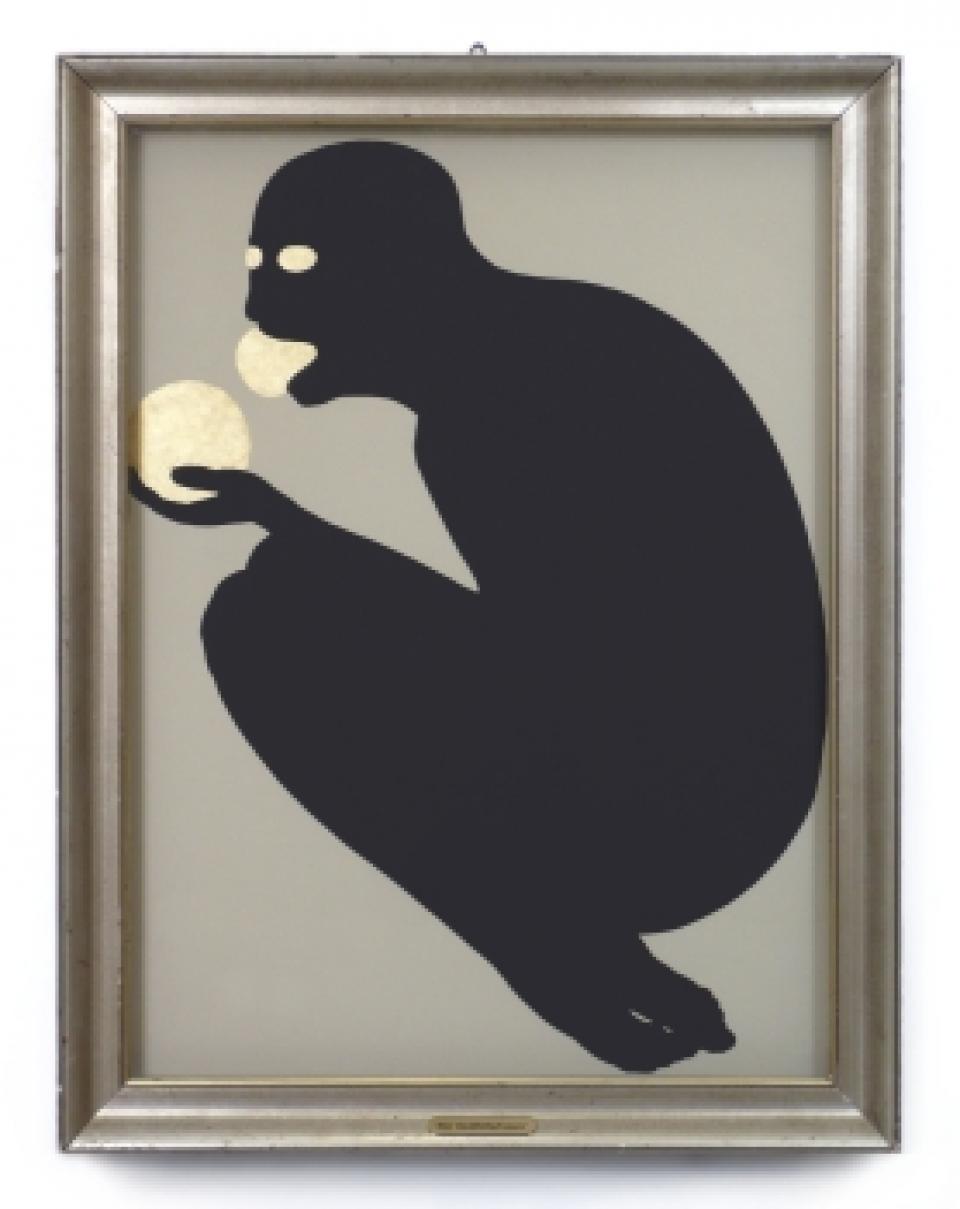
Der Goldbällefresser III, 2007, acrylic, gold leaf in glazed showcase, 79 x 61 x 6 cm
-
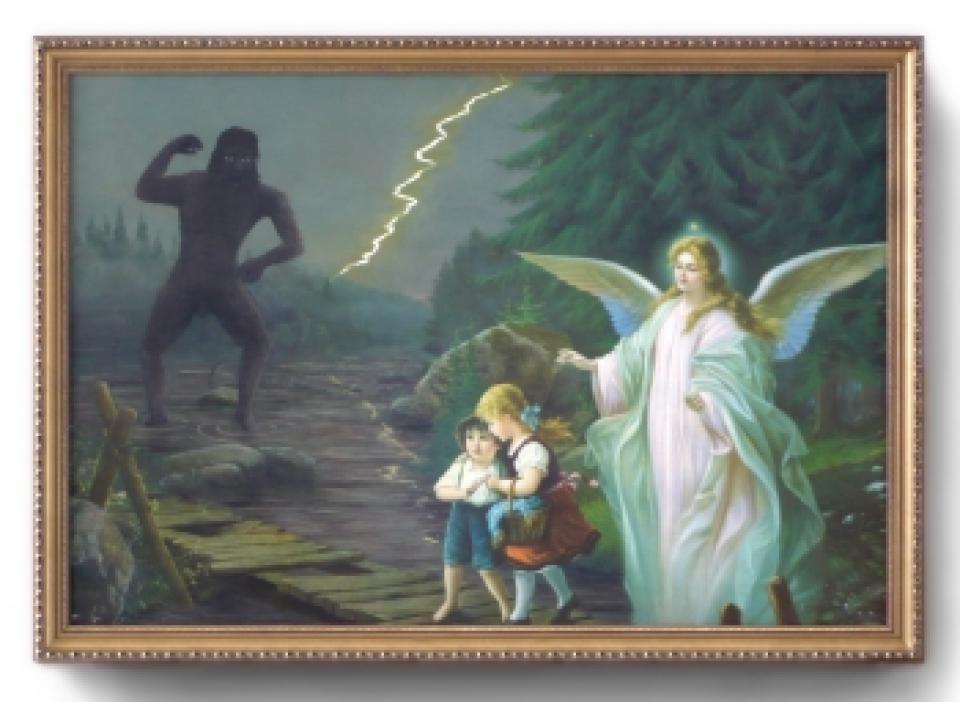
Der kleine Junge hat Angst vor dem Schwarzen Mann, 2007, picture object with irregular lightning and thunder sound from a black box, which is mounted behind the picture, 75 x 108 x 26 cm
-
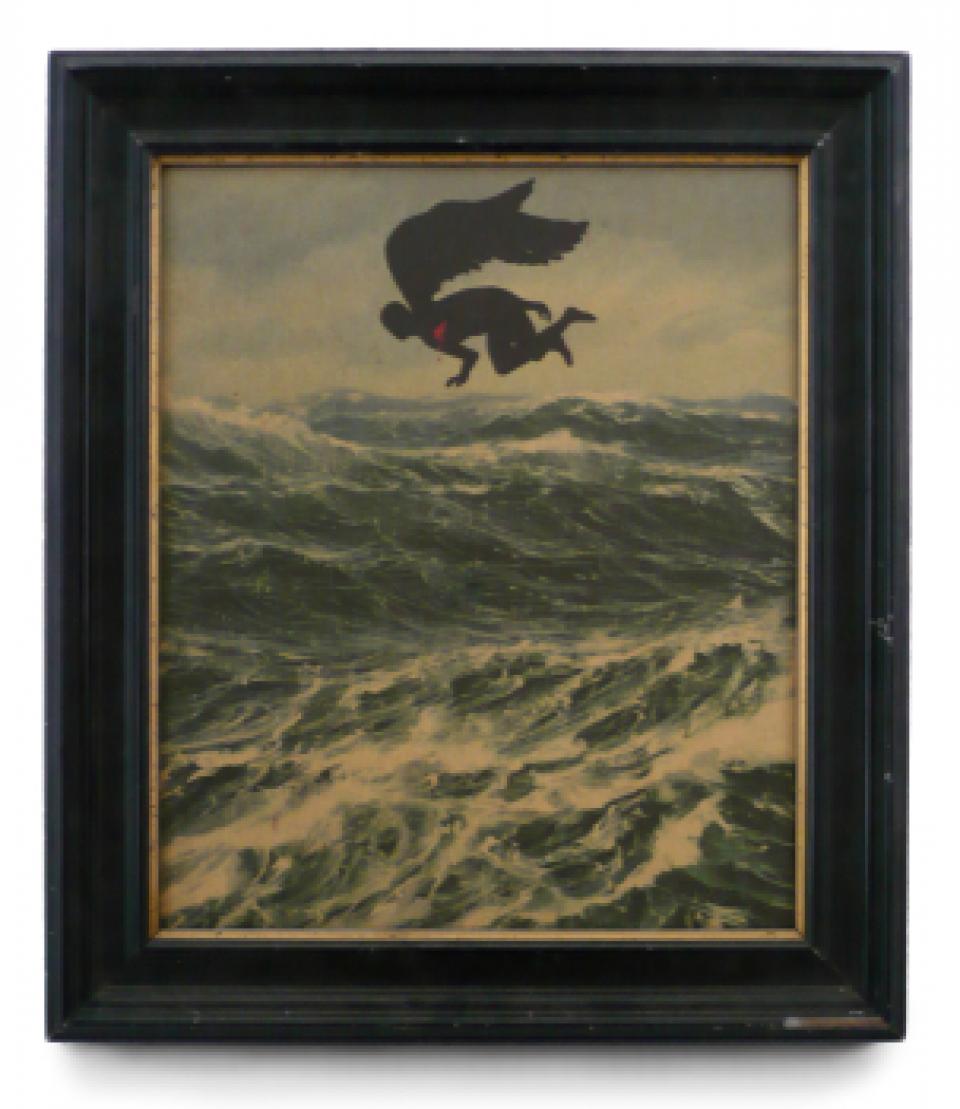
Engel III, 2007, acrylic on art print, glazed frame, 44 x 39 cm
-

Gloria II/II, 2007, acrylic on hardboard, glazed frame, 40 x 35 cm
Banderole: "I'm bad, but I'd be much worse if I didn't know I was bad."
-
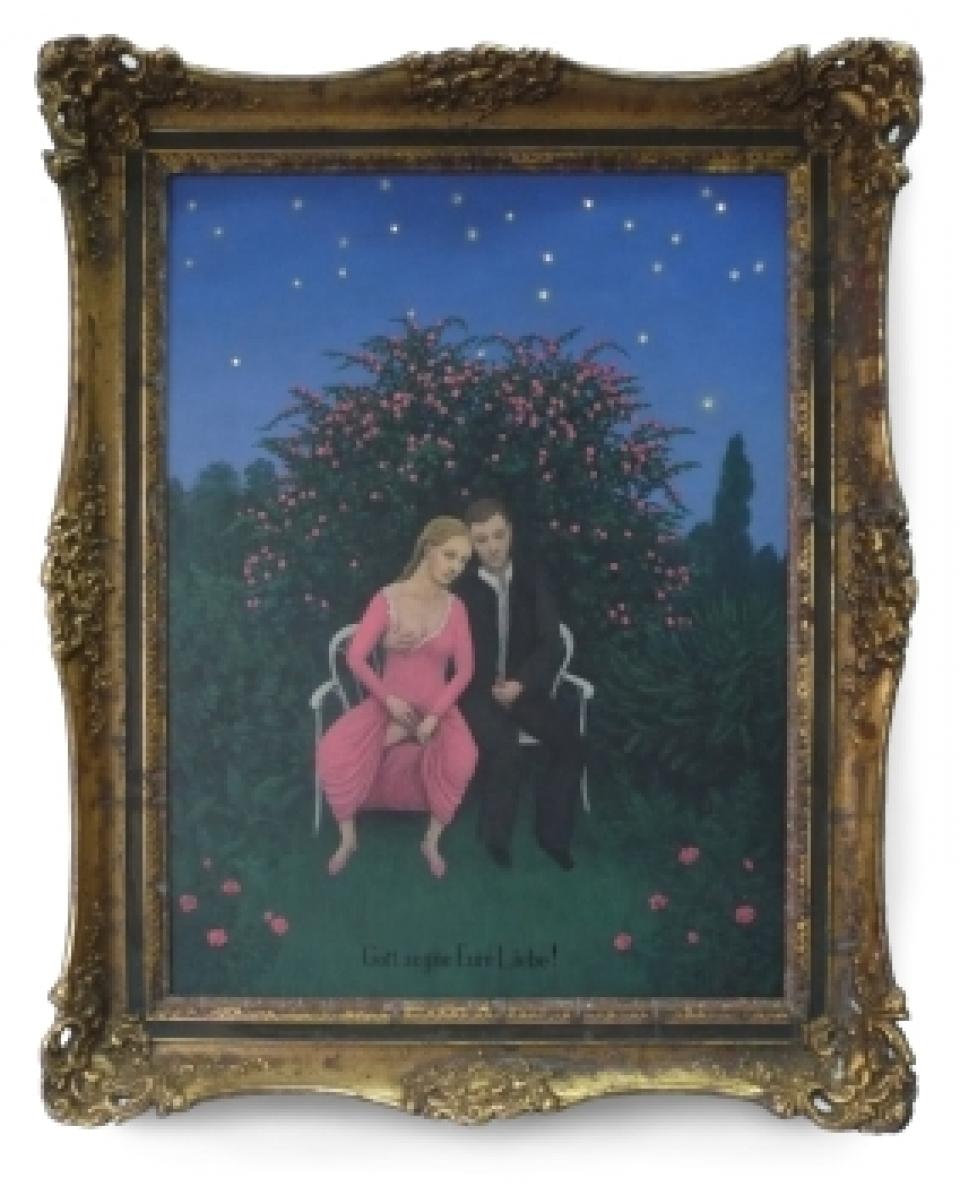
Gott segne Eure Liebe!, 2007, acrylic on hardboard, program light chain, glazed frame, 100 x 80 x 12 cm
The starry sky is illuminated with a program light chain, which lets stars slowly light up and extinguish alternately.
-

Berührung, 2006, Image section in glazed frame, 16 x 19 cm
-
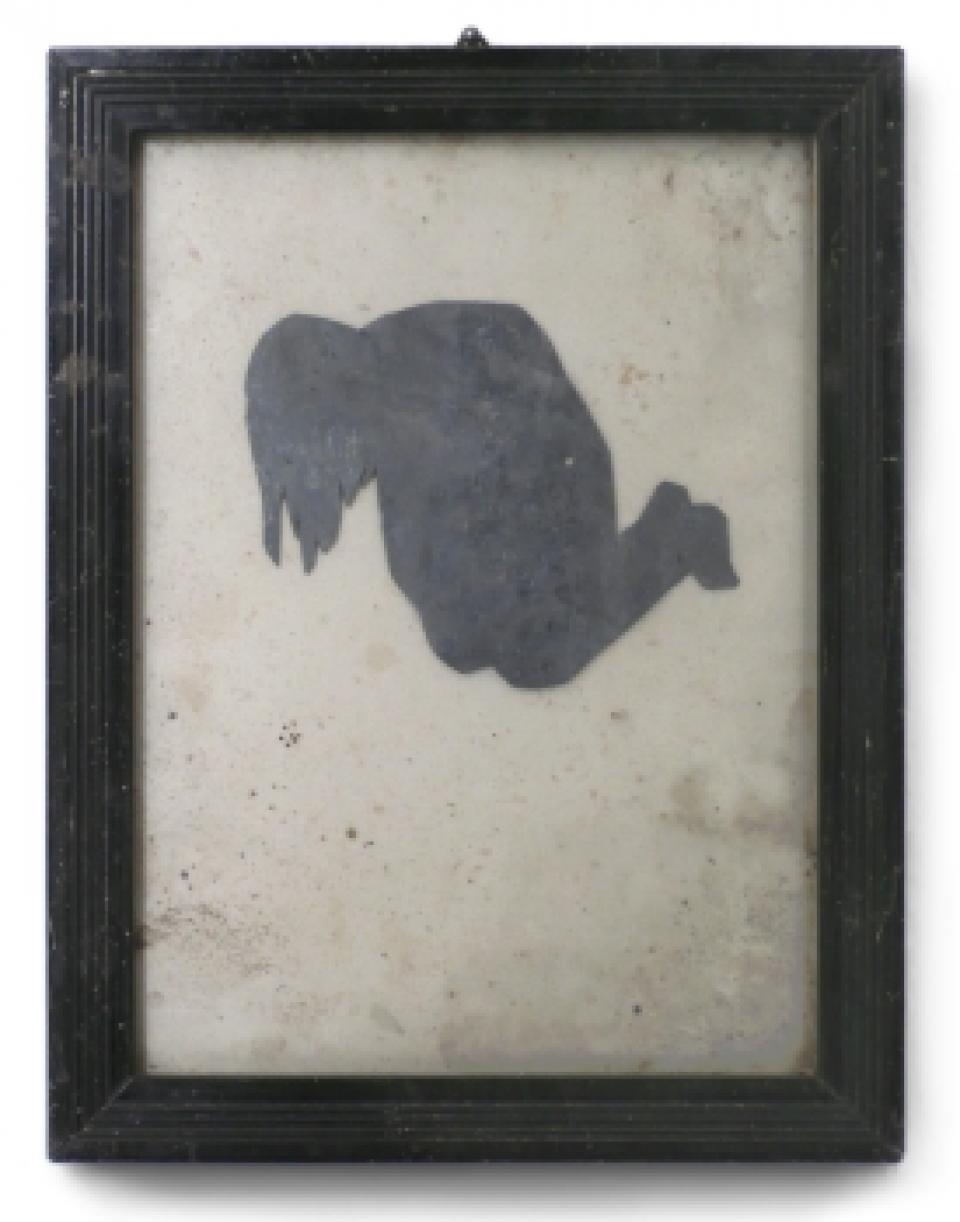
Bleimann, 2006, Lead, glazed frame, 24 x 19 cm
-

Das Mädchen und der Schwarze Mann, 2006, acrylic on art print, glazed frame, 55 x 43 cm
If you still have courage, thank God and be content.
private collection
-
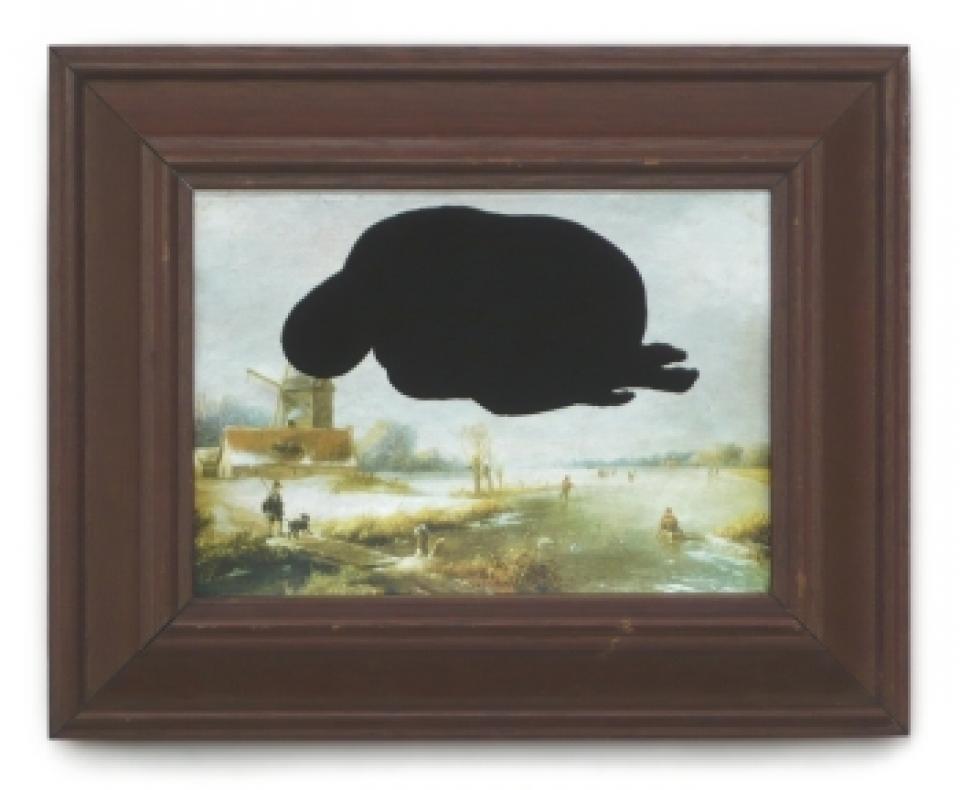
Der Überflieger, 2006, acrylic on effect print, frame, 20 x 25 cm
-

Fliehende, 2006, C-Print, glazed frame, 13 x 10 cm
private collection
-
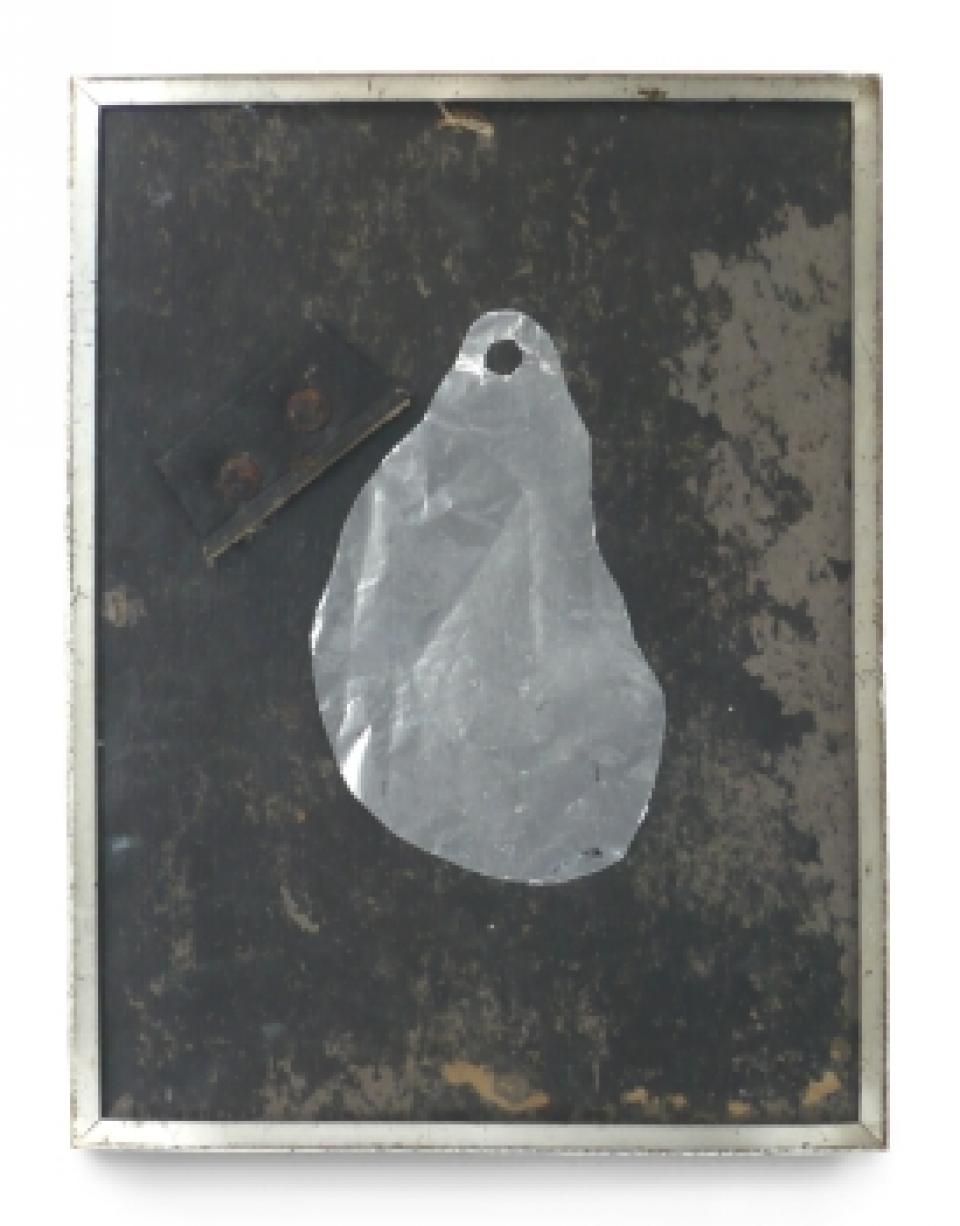
Ganzkörperrüstung mit Sprechloch, 2005, aluminium foil in glazed frame, 20 x 16 cm
-
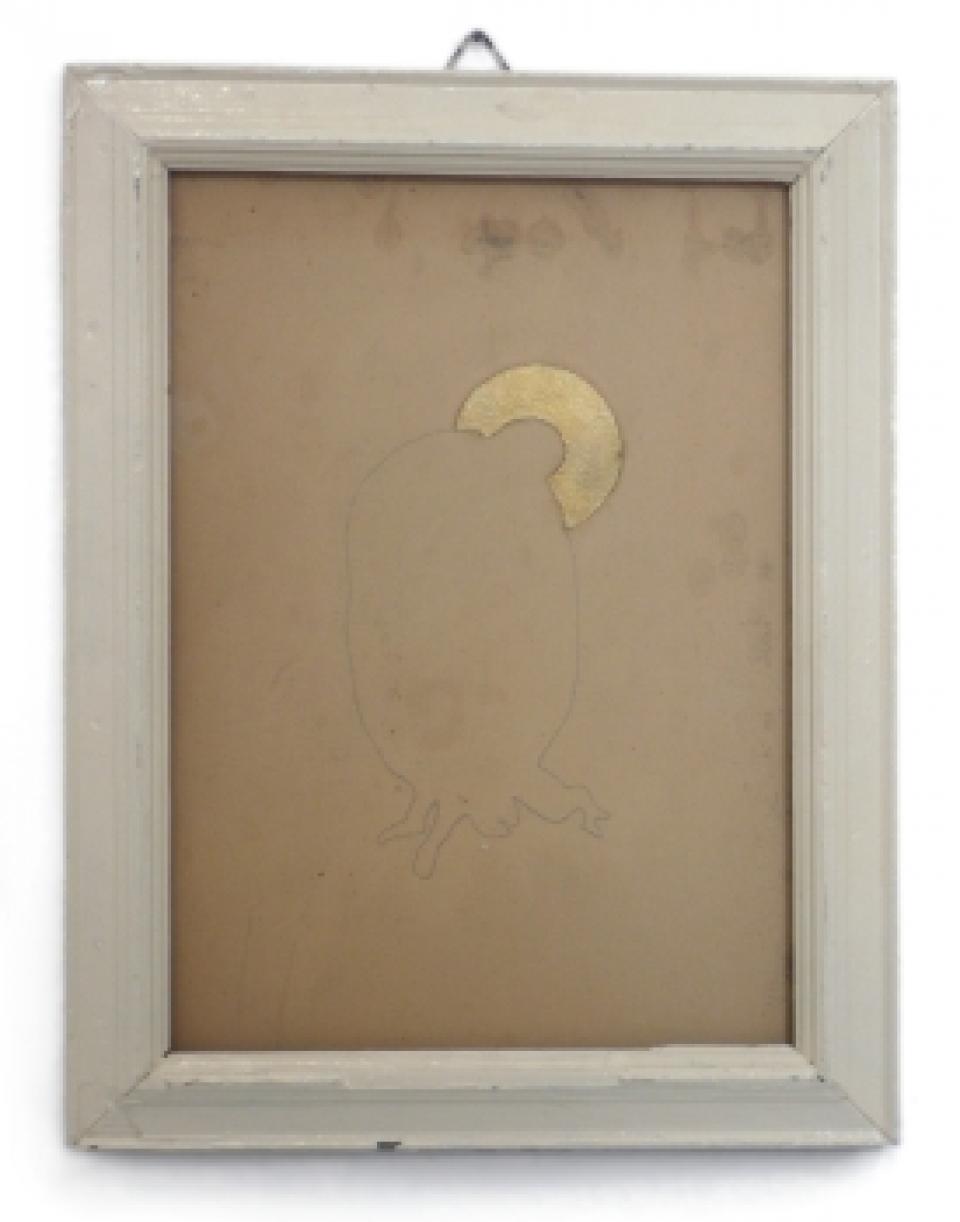
Heiligenbild I, 2005, pencil, decorative gold on cardboard, glazed frame, 45 x 35 cm
-

Heiligenbild IV, 2005, acrylic, gold leaf on canvas, artificial flowers, ca. 135 x 95 cm
-
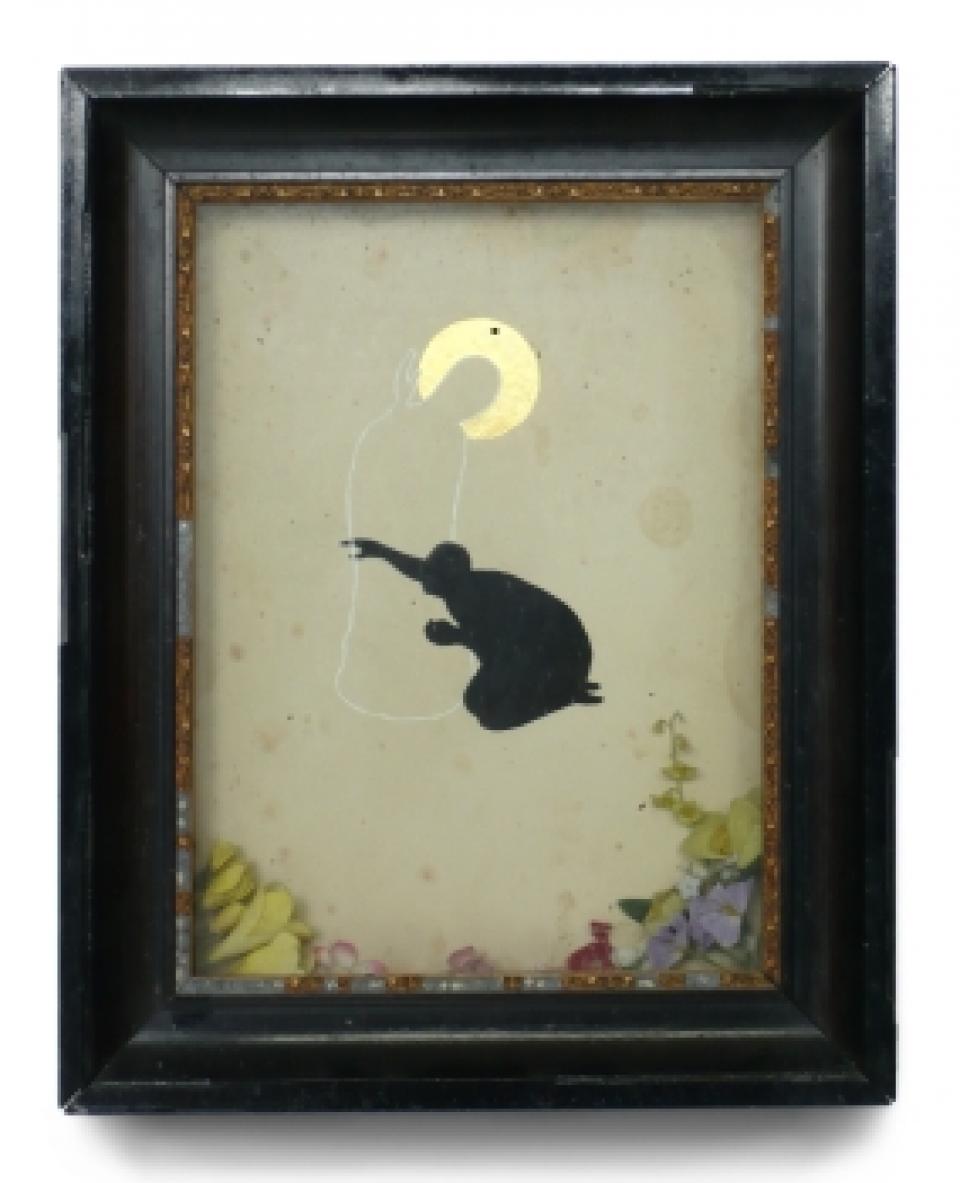
Heiligenschrein I, 2005, acrylic, decorative gold on hardboard, artificial flowers, glazed showcase, 50 x 40 x 7 cm
-
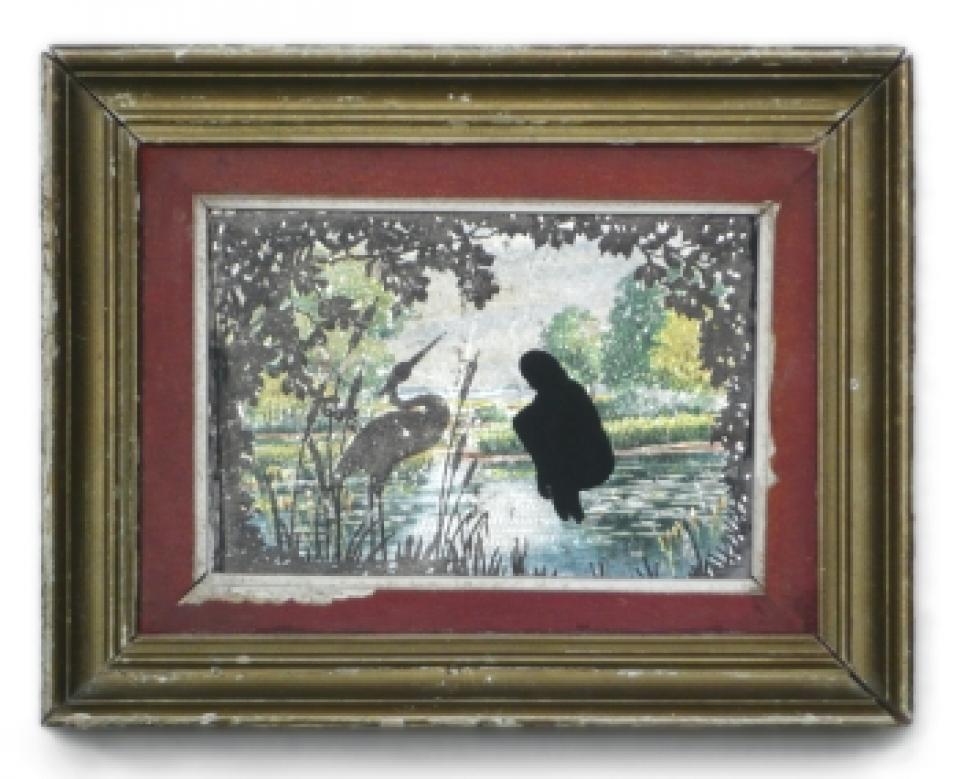
Im Paradies, 2005, acrylic on light effect print, frame, 17 x 22 cm
-

Hommage an Otto Quate II, 2004, acrylic on paper, glazed frame, 20 x 15 cm
-
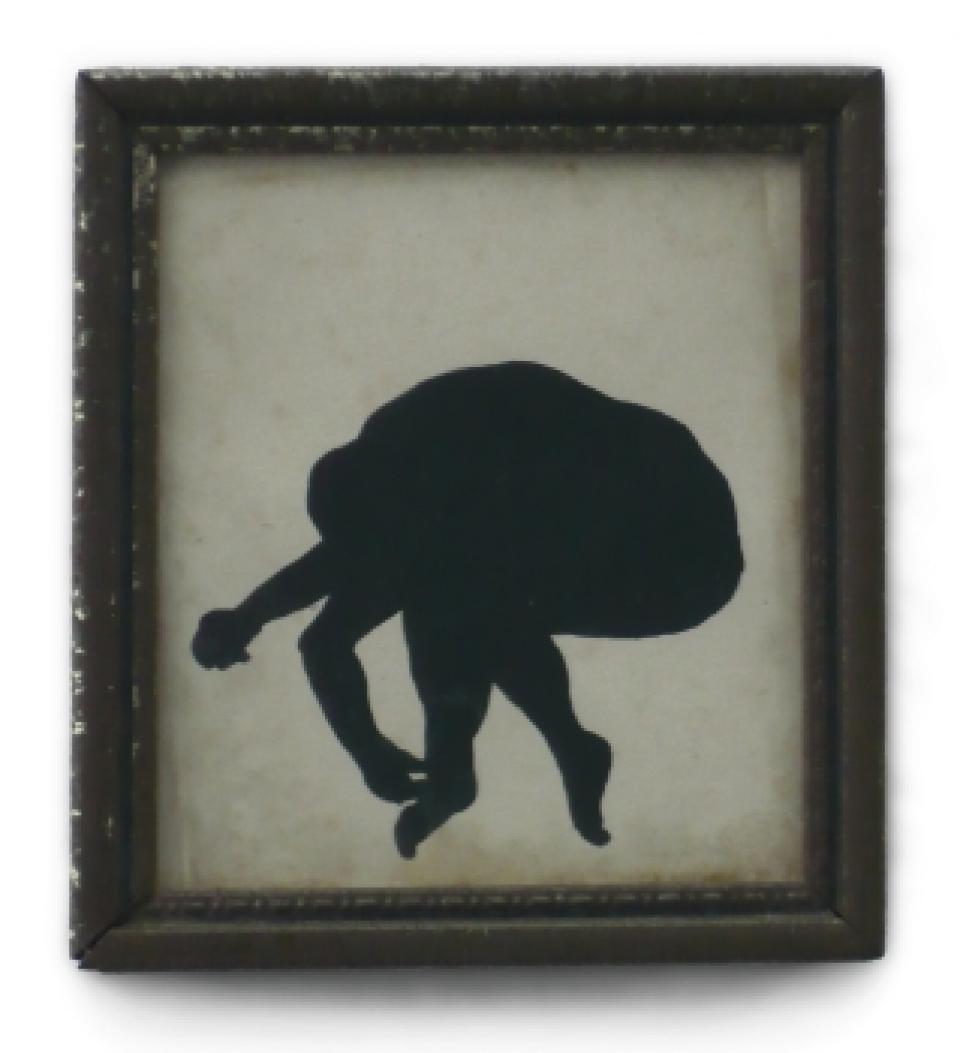
no title, 2004, acrylic on paper, glazed frame, 13 x 12 cm
-
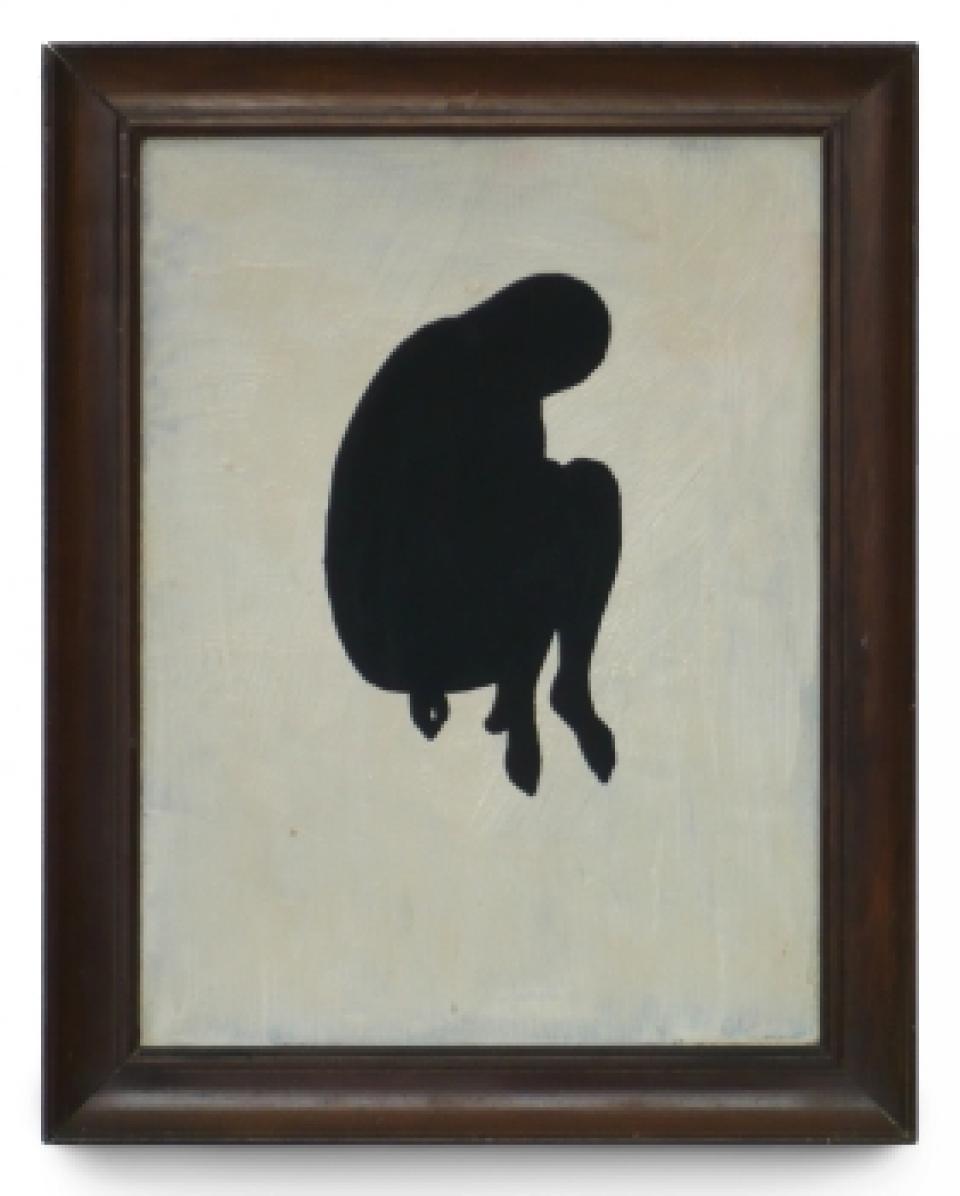
Im Kosmos, 2004, arcyl on hardboard, frame, 46 x 36 cm